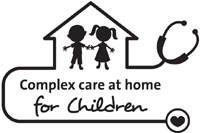Indications:
- Regular changes of the tracheal cannula are required in order to maintain the patency and the effectiveness of the tracheostomy.
- Below is a suggested method that can serve as a guide; discuss the specific type of medical supplies and equipment used for your child with your child’s healthcare team.
Considerations:
- Changing tracheal cannula is simple but for safety reasons, it is recommended that it be performed by 2 adults. The first person stabilizes the tracheal cannula by placing their fingers on the flanges and removes the old cannula while the second person inserts the new one.
- It is normal that that your child feels a bit of discomfort in their neck near the tracheostomy after changing the tracheal cannula.
- Changing the tracheal cannula can also cause an increase in cough and secretions (that can be pink in color) for a few hours. If this persists, contact your child’s healthcare team.
- Normally this procedure takes place easily; occasionally it may be difficult to reinsert the tracheal cannula due to swelling or irritation of the trachea. Refer to section “Frequently asked questions/ Resistance or impossibility of tracheal cannula reinsertion” if needed.
- If the type of tracheal cannula used by your child is reusable, it is important to follow the manufacturer’s recommendations regarding the number of uses.
- Good handwashing is essential before and after providing care.
- Ensure the comfort of your child during the care by using different positioning and distraction techniques.
Frequency:
- The frequency of regular tracheal cannula changes is determined by your child’s healthcare team.
- It is necessary to change the tracheal cannula if it is blocked (ex: accumulation of secretions, foreign object); these situations should be discussed with your child’s healthcare team.
- Preferably, should be done before meals or two hours after meals to avoid vomiting or reflux.
Required materials:
The method presented is for a simple non fenestrated, cuffless tracheal cannula. Refer to your child’s healthcare team for any adjustments required to the method if your child uses a 2 part tracheal cannula, fenestrated or a cuffed cannula.
Refer to your child’s healthcare team if the material, sequence and steps taught to you are different than those described.








